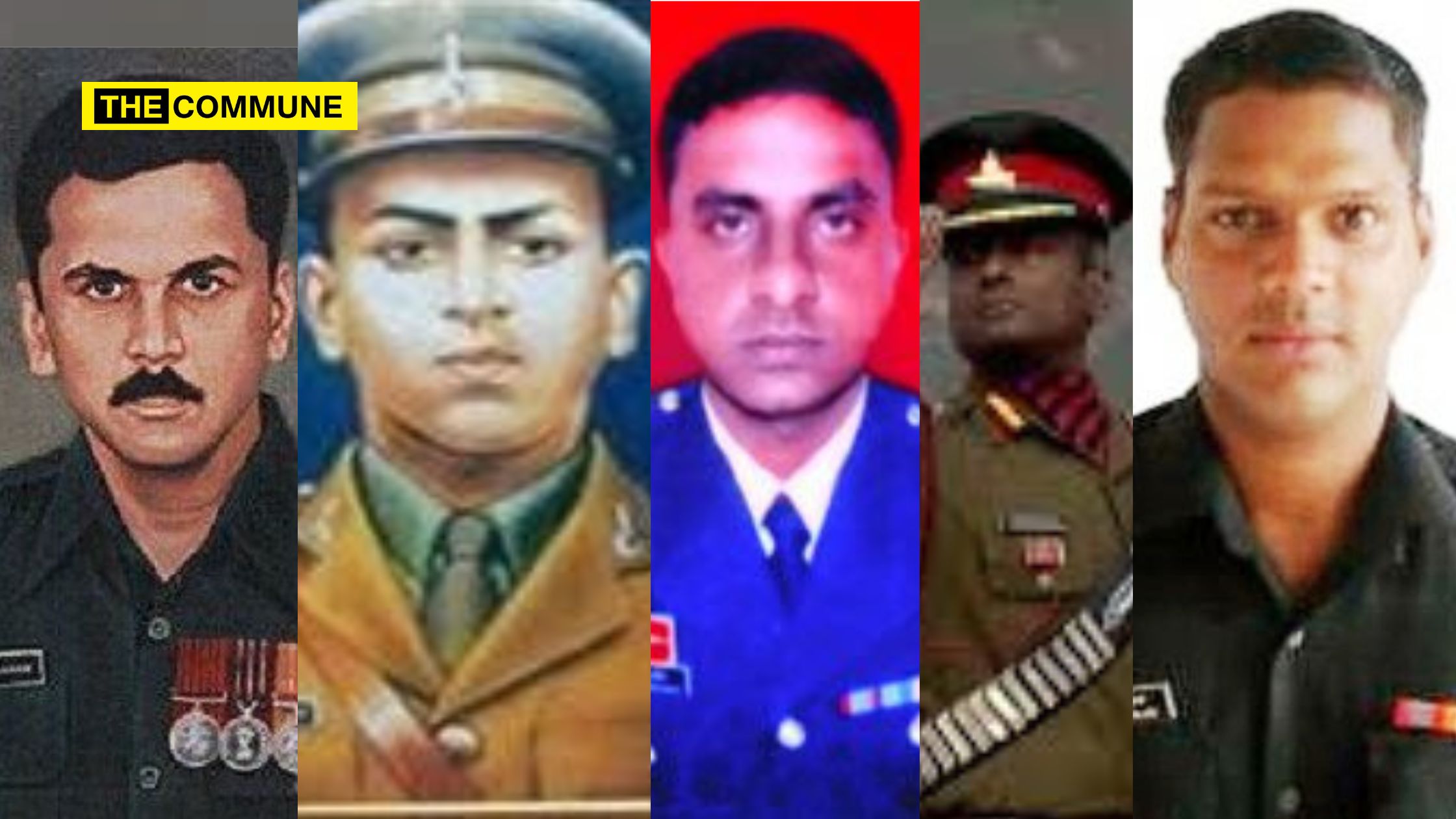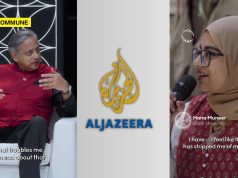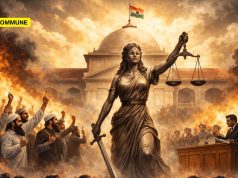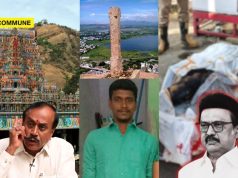
We seem to have lost touch with figures like Pasumpon Muthuramalinga Thevar and his devoted followers, who once rallied behind Subhash Chandra Bose in the struggle for India’s independence. The pride Tamil families once felt when declaring their sons’ service in the “Pataalam” (Armed Forces) — expressed with a beaming smile and a proud twirl of the moustache — has faded from the public consciousness. Yet, the spirit of sacrifice endures; Tamil Nadu continues to send its brave souls to defend our nation at the most challenging borders, standing resolute against formidable enemies. However, the fervor and charm that once defined this pride have become muted in our collective memory.
Despite the prevailing Dravidianist narrative that often promotes a separatist or anti-India sentiment in Tamil Nadu, the state’s deep-rooted tradition of military service stands strong, with Tamil families proudly sending their sons and daughters to serve in the Indian Armed Forces. Throughout history, Tamil soldiers have demonstrated extraordinary valor and unwavering dedication, earning the highest military honors, including the prestigious Ashok Chakra and Param Vir Chakra. These awards symbolize not only the courage and sacrifice of individuals but also the profound patriotism that continues to resonate within Tamil society. The legacy of these Tamil heroes is a testament to the enduring spirit of unity and loyalty to India, shining brightly despite contrasting political narratives.
Param Vir Chakra Recipients
The Param Vir Chakra (PVC) is India’s highest military honor awarded for exceptional bravery in the face of enemy action. Established on 26 January 1950, it is awarded to personnel of the Indian Armed Forces and recognizes acts of valor that go beyond the call of duty. The medal features a circular silver design with a depiction of the Ashoka Lion and is inscribed with the words “Param Vir Chakra.” Recipients are celebrated for their courage, leadership, and commitment to their country, often making the ultimate sacrifice in service to the nation.
Among the 21 recipients of the Param Vir Chakra, Major Ramaswamy Parameswaran stands out as a remarkable figure from Tamil Nadu. On January 2023, Prime Minister Narendra Modi named 21 of the largest unnamed islands in the Andaman and Nicobar Islands in honor of these Param Vir Chakra awardees, on the occasion of with Parakram Diwas, the birth anniversary of Netaji Subhas Chandra Bose.
Major Ramaswamy Parameswaran – Param Vir Chakra
Major Ramaswamy Parameswaran was born on 13 September 1946, in Bombay, Maharashtra. The son of Mr. K S Ramaswamy and Mrs. Janaki, he completed his education at SIES (South Indian Education Society) High School, Mumbai in 1963. He then graduated in science from SIES college in 1968. Subsequently, he enrolled in the OTA in Chennai and graduated on 16 June 1972. He was commissioned into the 15 Mahar of the renowned Mahar Regiment of the Indian Army and served there for eight years.
In 1981, Maj Parameswaran married Uma, a poet and writer, marking the beginning of his joyful married life. He was later reassigned to the 5 Mahar battalion in 1983. During his tenure with both the 15 Mahar and 5 Mahar battalions, Maj Parameswaran participated in numerous counter-insurgency operations in the North East region, quickly establishing a reputation for his resolute determination and unwavering leadership. Endearingly known as “Parry Sahib” by his troops, he was always at the front during the difficult missions taken on by his unit. When Op Pawan commenced, Maj Parameswaran was selected to serve with the 8 Mahar battalion, one of the initial units deployed in Sri Lanka in 1987.
Operation Pawan – 25 Nov 1987
Maj Parameswaran’s unit was part of the 54 Infantry Division assigned to oversee the execution of the Indo-Sri Lanka accord signed on 29 July 1987. Following the arrival of Indian forces in August 1987, the militants were expected to surrender; however, the notorious LTTE reneged and launched an assault against Indian forces. Late on the night of 25 Nov 1987, Maj Parameswaran was ordered to lead a group of soldiers on a reconnaissance mission in Kantharodai near Uduvil in Jaffna, the LTTE’s stronghold. As they proceeded to locate a cache of weapons hidden by the LTTE militants, they were ambushed by a group of heavily armed LTTE fighters. Maj Parameswaran and his team of approximately 30 soldiers inadvertently entered the militants’ hideout and came under heavy fire from all angles.
The militants were armed with AK-47s, grenades, explosives, and devastating HMGs (Heavy Machine Guns) that caused significant damage. The LTTE fighters had also mined the area, complicating the soldiers’ movements and placing them at a severe disadvantage. Maj Parameswaran swiftly evaluated the seriousness of the situation and resolved to initiate a counter-ambush to protect his troops. Taking 10 of his men, he advanced to put his strategy into action. Amid constant fire from HMGs, Maj Parameswaran fought valiantly and continued to encircle the militants. With disregard for his own safety, he dropped to his stomach and crawled forward through the coconut grove toward the ambush site.
Maj Parameswaran surprised the militants when they realized they were surrounded. However, a burst from an HMG fired by a sniper positioned in a coconut tree struck him on his left wrist, nearly severing his hand. Undaunted, he charged at the nearest militant, seizing his weapon and shooting him down. Just then, another HMG burst hit him in the chest. In his pocket, he had a Mini Clear pistol and ammunition intended for sending a success signal. The rounds detonated upon impact from the HMG and Maj Parameswaran fell to the ground, becoming a martyr. Though his soldiers were devastated by the loss of their determined commander, they drew inspiration from his bravery and successfully repelled the militants.
Maj Ramaswamy Parameswaran was awarded the nation’s highest honor for bravery, the “Param Vir Chakra,” in recognition of his extraordinary courage, unyielding fighting spirit, and ultimate sacrifice. He became the sole recipient of the PVC award from the IPKF operation in Sri Lanka and the first from OTA Chennai to receive this prestigious recognition.
Ashoka Chakra Recipients
The Ashoka Chakra is India’s highest peacetime gallantry award, recognizing acts of valor and self-sacrifice by military personnel. Instituted on 4th July 1952, it is awarded for courageous actions performed during peacekeeping operations and in the face of enemy attacks. The medal features a representation of the Ashoka Lion, symbolizing courage and honor. Recipients of the Ashoka Chakra are celebrated for their extraordinary bravery, commitment to duty, and contributions to the nation, often serving as inspirations for future generations.
Second Lieutenant P.M Raman – Ashoka Chakra
2nd Lt Pollur Mutthuswamy Raman was born on 4th December 1934 in the northern Arcot district of Tamil Nadu. The child of an Army officer, Maj Mutthuswamy from the Army Medical Corps and Savitri, 2nd Lt Raman was the second of seven siblings. 2nd Lt Raman received his early education in Burma and later attended Saraswati High School and Wadia College in Pune. He was a bright and gentle individual, well-liked by both teachers and peers alike.
In 1950, 2nd Lt Raman completed his SSC examination and, while in his first year of college, was selected for the National Defence Academy. He was commissioned into the Army as a 2nd Lt in 1955 at the age of 21. He joined the Sikh Light Infantry Regiment, a unit renowned for its brave soldiers and numerous battle honors. For his initial assignment, 2nd Lt Raman was posted to NEFA (North East Frontier Agency), now known as Arunachal Pradesh.
Nagaland Operation – 03 June 1956
On 02 June 1956, 2nd Lt Raman’s unit obtained intelligence regarding the presence of Naga militants in Chephema village, Nagaland. After evaluating the circumstances, it was decided to initiate an operation to apprehend the militants as soon as possible. Consequently, an assault team led by 2nd Lt Raman sprang into action in the early morning of 03 June 1956 as planned. 2nd Lt Raman and his soldiers arrived at the suspected area around 5 am. Soon, the troops identified the militants, who opened fire upon being challenged.
The militants were heavily armed, utilizing light machine guns, sten guns, and rifles. Due to the fog and darkness, identifying the militants’ positions was quite challenging. However, 2nd Lt Raman suddenly noticed movement in a nearby hut and rushed towards it. In a swift and brave maneuver, he fired and killed two militants. Meanwhile, one of the militants hurled a hand grenade at him, which fortunately did not injure him as he managed to escape just in time.
2nd Lt Raman continued to fire, taking down one more militant before he found himself encircled by militants on all sides. One of the militants threw another grenade that detonated a yard away, damaging his hat and wounding him. Undeterred, he persevered in his attack, instilling panic among the militants. Sensing imminent defeat, some of the militants began to flee, but 2nd Lt Raman pursued them and eliminated another militant. However, one of the militants emerged from hiding and shot at him, inflicting severe injuries. Even this did not stop him; he retaliated by throwing a grenade at another militant, killing him. He continued to issue orders and direct fire until he eventually fell unconscious. 2nd Lt Raman later succumbed to his wounds and was martyred before reaching the age of 22. His daring actions inspired his troops, leading them to ultimately destroy the militants’ hideout and accomplish their mission successfully.
2nd Lt P M Raman was posthumously awarded the nation’s highest peacetime gallantry honor, the “Ashok Chakra,” in recognition of his remarkable bravery, unwavering leadership, and ultimate sacrifice.
Major Dinesh Raghu Raman – Ashoka Chakra
Major Dinesh Raghu Raman was born in Kancheepuram district to SK Murthy and Mala Murthy on 6th April 1978. He completed his primary education at Kendriya Vidyalaya, INA Colony, New Delhi. Subsequently, he enrolled in the esteemed National Defence Academy in 1996 and was commissioned into the 19th Battalion of the Jat Regiment, a unit renowned for its valiant soldiers and numerous battle accolades. Despite a brief career, he held various positions and earned high regard from his superiors for his commitment and leadership abilities. He was also honored with the Chief of Army Staff Commendation medal for his contributions to Operation Parakram in the Drass sector.
Baramulla Operation – 02 Oct 2007
Following several years of service with his unit, Maj Raman was later assigned to the 34 Rashtriya Rifles Battalion in the J & K region in 2006. In June 2007, he executed a highly successful operation “Op Narawar,” resulting in the elimination of three hardline terrorists in his operational area. On 02 October 2007, Maj Raman was tasked with initiating an operation in a village in Baramulla to root out the terrorists hiding there. At 0820 hours that day, Maj Raman deployed his company to secure the suspected area. Around 0855 hours, while approaching the suspected structures, Major Raman heard cries for help from a fellow officer who had sustained serious injuries during the ongoing firefight.
Maj Raman quickly assessed the situation and advanced towards his injured comrade. Demonstrating remarkable camaraderie and esprit-de-corps, he crawled toward the wounded officer under intense enemy fire. He successfully evacuated him and two other injured soldiers to a safer location. Maj Raman then targeted the two terrorists responsible for significant troop casualties and engaged them in a fierce close-quarter combat, ultimately killing both. However, additional terrorists concealed in a nearby house opened fire on Major Raman, creating another front in the gunfight. During the subsequent exchange, Maj Raman was seriously injured. Undaunted, he continued to lead and inspire his troops, keeping the terrorists pinned down until he lost consciousness. He was airlifted to the military hospital in Srinagar, where he tragically succumbed to his injuries. Maj Raman was a devoted soldier and an exemplary officer who sacrificed his life in the service of his country.
Major Dinesh Raghu Raman was posthumously awarded the nation’s highest peacetime gallantry honor, the “Ashok Chakra,” in recognition of his extraordinary bravery, camaraderie, fighting spirit, and ultimate sacrifice.
Colonel D. Sreeram Kumar – Ashoka Chakra
Colonel D. Sreeram Kumar, born on 11 January 1981, is a serving officer in the Indian Army, recognized for his valor with the Ashoka Chakra, India’s highest peacetime gallantry award, in 2010. Hailing from Kovilpatti, he completed his schooling at Sainik School in Amaravathinagar, graduating in 1998, and later pursued his undergraduate studies at The American College in Madurai.
Sreeram Kumar joined the Officers Training Academy in Chennai in October 2002 and was commissioned into the 90 Medium Regiment (Artillery) on 20 March 2004, as a lieutenant. He transitioned to a regular commission on 20 March 2009, with seniority dating back to 20 October 2004. He was promoted to captain on 20 October 2006, and later served as an acting major beginning 24 August 2008, with 39 Assam Rifles during Operation Orchid in Arunachal Pradesh and Operation Hifazat in Manipur.
On 23 October 2008, Major Sreeram Kumar launched an operation against a group of 10–15 armed terrorists in Heingang Heibi Makhong, Imphal East District, based on credible intelligence. During the encounter, he and his team faced heavy automatic fire from the terrorists. Displaying remarkable courage, he engaged the attackers, killing two of them. He then directed his team to provide covering fire and, showing extraordinary bravery, crawled closer to eliminate the remaining terrorists at point-blank range. For his exceptional leadership and gallantry, he was awarded the Ashoka Chakra on 15 August 2009.
Following this recognition, Kumar continued his career as an instructor at the Indian Military Academy (IMA). He received a substantive promotion to major on 20 October 2010, and was promoted to lieutenant colonel on 20 October 2017. Most recently, he was elevated to the rank of colonel by selection on 31 January 2021, with seniority effective from 26 October 2019.
Major Mukund Varadarajan – Ashoka Chakra
Major Mukund Varadarajan was born on 12 April 1983 in the Kozhikode district of Kerala. Son of R Varadarajan and Geetha, he spent his childhood in Tamil Nadu and had two sisters, Swetha and Nithya. He earned a Bachelor of Commerce degree from Sri Chandrasekharendra Saraswathi Viswa Mahavidyalaya in Enathur, Tamil Nadu, and a diploma in journalism from Madras Christian College in Tambaram. His grandfather and two uncles had also served in the army, which inspired Maj Mukund to pursue a military career. He was selected to join the Army by passing the Combined Defence Services Examination in 2005 and attended the esteemed OTA (Officers Training Academy) in Chennai.
In 2006, he was commissioned as a Lieutenant in the 22 Rajput Battalion of the Rajput Regiment, an infantry unit renowned for its fearless soldiers and numerous battle achievements. After nearly three years of service, he married his long-time friend Ms Indhu Rebecca Varghese on 28 August 2009, and the couple welcomed a daughter, Ashreya, born on 17 March 2011. His service included a tenure at the Infantry School in Mhow, Madhya Pradesh, as well as participation in the United Nations Mission in Lebanon. In December 2012, he was assigned to the 44 RR Battalion, deployed in J&K for counter-insurgency operations.
Qazipathri Operation (J&K) – 25 Apr 2014
In 2014, Maj Mukund’s unit, 44 RR, was stationed in the Shopian district of J&K and frequently engaged in counterinsurgency operations. The battalion, led by Col Amit Singh Dabas, operated from its headquarters at Zawora Manlo near the apple town of Shopian. After joining his unit, Maj Mukund took part in multiple counter-insurgency and counter-infiltration operations, demonstrating his capabilities on several occasions. On 25 April 2014, intelligence reports indicated the presence of dangerous terrorists, including Jaish-e-Mohammed commander Altaf Wani, in Qazipathri village in Shopian district. An operation was planned to eliminate the terrorists under Maj Mukund Varadarajan’s command. As planned, Maj Mukund acted swiftly with his troops and reached the suspected area within 30 minutes. The intelligence suggested these terrorists had also been involved in the recent killing of election officials.
At approximately 1500 hours, Maj Mukund divided his Quick Reaction Team (QRT) into six buddy pairs and established a cordon around the suspected two-story home in Qazipathri village. The house featured a large compound, an orchard, and two outbuildings. The soldiers quickly encountered the heavily armed terrorists, who opened fire on the assault team when challenged. The gunfire persisted for an hour without progress, as the terrorists were concealed and firing from advantageous positions. Recognizing the seriousness of the situation, Maj Mukund understood that a different tactical approach was necessary for a breakthrough. Alongside his comrade, Sep Vikram Singh, and under fire from their team, he crawled to the entrance of the house. Maj Mukund swiftly deployed an Improvised Explosive Device (IED) to blow up the entrance and charged inside with Sep Vikram Singh. In a rapid maneuver, Maj Mukund shot and eliminated one terrorist while simultaneously directing his troops’ fire.
The remaining two terrorists tossed grenades and, using the cover of the debris, escaped towards a cement outhouse. Maj Mukund and Sep Vikram Singh pursued them, throwing a grenade into the outhouse. The explosion killed one terrorist, but Jaish-e-Mohammed commander Altaf Wani survived and shot at Sep Vikram Singh, who was critically injured by two bullets to the neck and jaw. Tragically, he succumbed to his wounds and was martyred. Without hesitation for his safety, Maj Mukund charged forward, unleashing gunfire on Altaf Wani, killing him instantly. However, during the intense gunfight, Maj Mukund also sustained three gunshot wounds and soon collapsed. He was immediately taken to the Army’s 92 Base Hospital in Srinagar, but tragically lost his life en route, passing away in the arms of the regimental medical officer. Maj Mukund Varadarajan was a dedicated soldier and brave officer, who sacrificed his life at the age of 31 in the line of duty. In recognition of his extraordinary valor and ultimate sacrifice, Maj Mukund was awarded the nation’s highest peacetime gallantry honor, the “Ashok Chakra.” He became the fourth recipient of the “Ashok Chakra” from the state of Tamil Nadu, following Second Lieutenant P.M Raman of Tiruvannamalai district (1957, posthumously), Major Dinesh Raghu Raman of Kancheepuram district (2008, posthumously), and Major D Sreeram Kumar of Madurai district (2010).
(With Inputs From Honour Point – Online Memorial For Fallen Soldier)
Satheesh is a blogger.
Subscribe to our channels on Telegram, WhatsApp, and Instagram and get the best stories of the day delivered to you personally.




